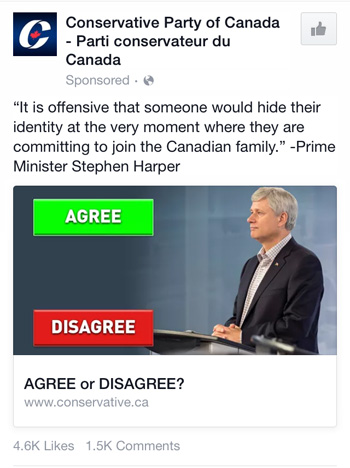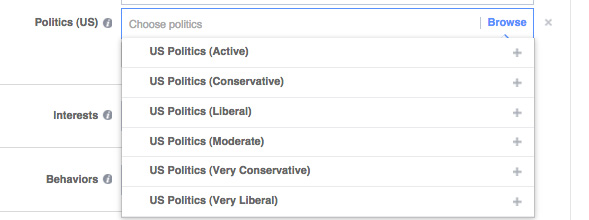It’s campaign season again, and just like the seasonal changing of the leaves and the inevitable cold to follow… so comes the parade of colorful political signs on lawns and lining of roadways. We feel that over the years, political campaigns have really not embraced the power of digital mediums. Obama’s last campaign being the major exception. In Canada however, things have yet to catch on. We decided to write about it.
In order to get an accurate sense of what types of digital marketing each of these parties were using, we used some tools and tactics and browsed around their websites, liked all their social pages (God help me) and looked up relevant web content on various devices to see what ads we’d see. From what we noticed, we can make the following probable conclusions:
– Digital Marketing isn’t a real marketing medium for election candidates.
– Edmonton is not a market worth targeting very heavily with digital advertising.
We were a little saddened to see that utter lack of use of digital advertising by these parties. Maybe it’s budget? Maybe it’s policy? Maybe it’s laziness? Maybe it’s simply the lack of knowledge of how digital marketing can educate and connect with audiences?
We did some digging.
It’s not policy. See here. It’s also not budget. See here & here. So where does that leave us? Somewhere smack dab in the middle of laziness and ignorance. Sad.
Apart from the Liberal party, which would receive a C+ grade in digital marketing class, every other party failed. With early voting already open, and the final vote coming in about a week, this may be too little too late for some parties, but regardless, here’s some tips for all parties on how to better leverage digital marketing for their political ends.
1) Use your assets


All political figures have a pretty widespread digital footprint. They have social media profiles, websites, and are a common topic across the news and bloggers these days. The question is, why aren’t they using this to their advantage? Whether their following is large or small, there’s still plenty of ways to use digital advertising to make that following increase exponentially.
Remarketing is an obvious (in our books anyway) way to track visitors on your web properties, whether that is Facebook, Twitter or your many websites. Simply tracking your visitors is a huge asset, which through the use of ads you can reach on a whim. Only two of the major parties even had the tracking code on their websites. We feel that this is a huge missed opportunity… one that we’ll dive into deeper a little later into this post.
Justin Trudeau and the Liberal’s have the most followed social profiles on the web. This can be incredibly powerful, but how are they using it? We have seen no promoted posts in our feeds, no mention of their platform, nothing. They aren’t alone either… this is the same for every party on Facebook. While social platforms may be considered taboo due to how quickly things can escalate and become negative, if done right, they still can have incredible power. Even if things do go negative, your group of supportive fans will have your back and often go to bat for you. There’s another really cool way to use these audiences to your benefit, and we’ll get into that in the remarketing section of this post.
Finally, as a national candidate each party has their name plastered across thousands of news websites and articles all over the web. Using contextual advertising, you can help reinforce your message, create awareness, and draw people to your website by targeting relevant terms to your name and party. Want to change some minds? Write compelling ads against your competition targeting their names and parties.
2) Use History & Polls
Confucius once said “Study the past if you would define the future” and this is something these candidates should live by in their digital advertising tactics. Both Facebook and Google offer marketers the ability to target down to the postal code level. If parties wish to conserve budget, they could look to history – for historic polling numbers to determine where best to use their marketing dollars. Once the campaign is underway, work can then be done based on polling surveys, and early voting results to determine how additional budget could be spent. Should we market to an audience that already is likely going to vote for our party? Or should we focus our budget to locations that often swing? These are the types of questions parties can begin to ask themselves. The problem is though, as we’ll touch on in the next point, that you have to have the creative to target and speak to these audiences on the ready.
3) Change it up


We’ve seen a shocking lack of relevant and click-worthy ads. We’ve even seen some ads that should really be against Facebook ad policies altogether by the Conservatives, but that’s neither here nor there (see attached). To date the only ads we’ve seen focus on the party leader itself, and not the voting platform their working towards. We’ve even seen a few attack ads, which would be great if they were actually targeted properly. Overall, every party here failed miserably. As a Canadian citizen of voting age, I’m likely aware of who you are and what party you represent, but what I likely do not to know is what your parties principles are and what you stand for. You can use a variety of available targeting on digital mediums to ensure you’re hitting the right audiences as well. If I’m pro-environment, I may want to know Harper’s track history in this area. If I have 5 kids, I may want to know that Liberal’s plan to reverse income splitting. If I’ve simply been a recent visitor to your website, you may want to educate me on your platform through ads. The point is, you should have a ton of different creative made, in a variety of sizes (to maximize the amount of ad spaces you can fill), for a variety of different targets. Not a single party has done this, and instead we see campaign signs for the same party every 5 feet straddling a road. There’s a better use of this money, and whether your trying to win your riding or become to the majority political party in Canada… these tactics will help you.
4) Remarketing & Frequency
Remarketing can be a powerful ally in elections… especially with swing voters. There is literally no better (nor cheaper) way to follow-up with recent visitors to your web properties, whatever they may be. Remarketing is now offered on websites, Facebook, Youtube & Twitter… to name a few. You can share your party’s platform to these individuals and have it tailored exactly to match the content they’ve previous expressed interest in on your site. On the flip side, you can use certain metrics like time-on-site and pages per visit to make lists of users who are actively engaging with your content, versus those that bounce or leave quickly upon visiting. By doing this you can really hone your message, based on the perceived intent of your visitors. Individuals who leave quickly may be considering voting for other parties, and you can tailor a message to fit (and reduce your budget). Individuals who come back multiple times may be flipping between parties, trying to find which one they align with best, and therefore remarketing ads may provide the nudge they need to vote for you. Frequency of your ads is also important, set a limit and stay within it. If you let remarketing go haywire, you’re wasting your money. Generally if the user doesn’t respond after 7-10 impressions, your message is lost on them, and you should move on.
Finally, we touched on it earlier, but there is another powerful use for remarketing is the ability to create lookalike and similar audiences to your lists. This feature of Facebook and Google looks into the demographical make-up of your remarketing lists and finds new users outside of your list that match those demographics. This can be an incredibly effective way to reach new voters.
5) Facebook…
We’re not sure, but we feel that overall the parties have drastically underestimated the power of this platform. Of all the ad platforms on digital, this is the only one that would provide some comprehensive targeting towards people’s political beliefs. If we were in the US, targeting would be incredibly easy, as its literally built into Facebook’s ad platform (see attached).


As Canadians, we have to use some combination of interests.. which can include political parties and politicians to target individuals with ads. We can also do the legwork to find political sites and or figures who may represent a specific political viewpoint – John Stewart perhaps? Aside from this basic targeting method, friends of fans targeting could also prove fruitful.
Why stop at Facebook too? Twitter and Youtube offers plenty of targeting tools to hit your ideal audience.
In summary, digital marketing shouldn’t be an afterthought for election campaigns, it should lead the charge. Campaign signs are no different than billboards (although more plentiful) – they don’t harness the ability to connect and engage with your audience like digital mediums can. We hope, that as younger generations come of age, that political parties will begin to harness and embrace the power of digital more, and begin to move away from their “tried and tested” marketing methods of elections past to reach this more digital-dependent market. And of course, if they want help doing it, we’re here to help.
Photo Credit: http://si.wsj.net/public/resources/images/BN-KJ163_0917ca_J_20150917221021.jpg




